
Chevrolet Equinox Owners Manual
Warning Lights, Gauges, andIndicatorsInstruments andControls / Warning Lights, Gauges, andIndicators
Warning lights and gauges can signal that something is wrong before it becomes serious enough to cause an expensive repair or replacement. Paying attention to the warning lights and gauges could prevent injury.
Warning lights come on when there could be a problem with a vehicle function. Some warning lights come on briefly when the engine is started to indicate they are working.
Gauges can indicate when there could be a problem with a vehicle function. Often gauges and warning lights work together to indicate a problem with the vehicle.
When one of the warning lights comes on and stays on while driving, or when one of the gauges shows there may be a problem, check the section that explains what to do. Follow this manual's advice.
Waiting to do repairs can be costly and even dangerous.
Instrument Cluster
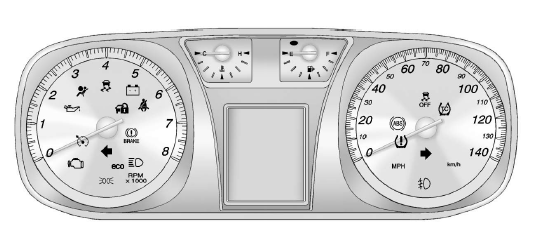
English Shown, Metric Similar
Speedometer
The vehicle's speed can be selected to display on the Driver Information Center (DIC) and the speedometer in either kilometers per hour (km/h) or miles per hour (mph). Telltales on the speedometer indicate whether kilometers or miles were chosen.
The DIC will show the vehicle's speed after the limit on the speedometer has been reached.
Odometer
The odometer shows how far the vehicle has been driven, in either kilometers or miles.
This vehicle has a tamper‐resistant odometer. The digital odometer will read 999,999 if it is turned back.
If the vehicle needs a new odometer installed, it must be set to the mileage total of the old odometer.
Tachometer
The tachometer displays the engine speed in revolutions per minute (rpm).
Fuel Gauge
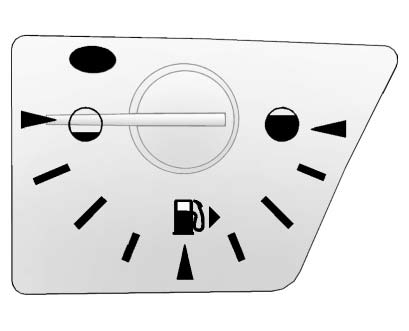
Metric
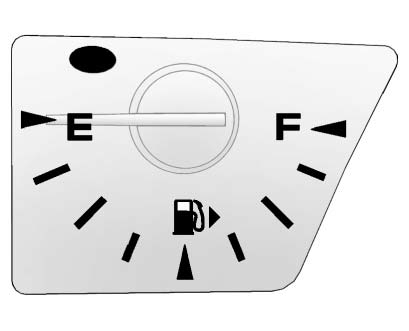
English
When the ignition is on, the fuel gauge shows about how much fuel the vehicle has left in the fuel tank.
An arrow on the fuel gauge indicates the side of the vehicle the fuel door is on.
The gauge will first indicate empty before the vehicle is out of fuel and the low fuel light comes on, but the vehicle's fuel tank should be filled soon.
Here are some situations that can occur with the fuel gauge. None of these indicate a problem with the fuel gauge.
• At the service station, the fuel pump shuts off before the gauge reads full.
• It takes a little more or less fuel to fill up than the gauge indicated. For example,
the gauge may have indicated the tank was half full, but it actually took a little
more or less than half the tank's capacity to fill the tank.
• The gauge moves a little while turning a corner or speeding up.
• The gauge takes a few seconds to stabilize after the ignition is turned on, and
goes back to empty when the ignition is turned off.
Engine Coolant Temperature Gauge

Metric
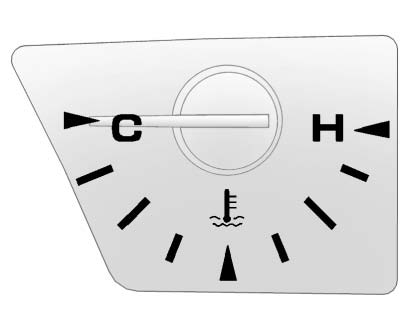
English
This gauge measures the temperature of the vehicle's engine.
If the indicator needle moves to the hot side of the gauge toward the colored line, the engine is too hot.
If the vehicle has been operated under normal driving conditions, pull off the road, stop the vehicle, and turn off the engine as soon as possible.
Safety Belt Reminders
Driver Safety Belt Reminder Light
There is a driver safety belt reminder light on the instrument cluster.
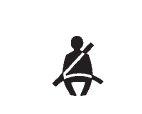
When the vehicle is started, this light flashes and a chime may come on to remind the driver to fasten their safety belt. Then the light stays on solid until the belt is buckled.
This cycle may continue several times if the driver remains or becomes unbuckled while the vehicle is moving.
If the driver safety belt is buckled, neither the chime nor the light comes on.
Passenger Safety Belt Reminder Light
There is a passenger safety belt reminder light near the passenger airbag status indicator.
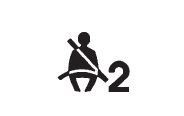
When the vehicle is started, this light flashes and a chime may come on to remind passengers to fasten their safety belt. Then the light stays on solid until the belt is buckled.
This cycle continues several times if the passenger remains or becomes unbuckled while the vehicle is moving.
If the passenger safety belt is buckled, neither the chime nor the light comes on.
The front passenger safety belt warning light and chime may turn on if an object is put on the seat such as a briefcase, handbag, grocery bag, laptop, or other electronic device. To turn off the warning light and/or chime, remove the object from the seat or buckle the safety belt.
Airbag Readiness Light
This light shows if there is an electrical problem with the airbag system. The system check includes the airbag sensor(s), passenger sensing system, the pretensioners, the airbag modules, the wiring, and the crash sensing and diagnostic module. For more information on the airbag system.

The airbag readiness light comes on for several seconds when the vehicle is started. If the light does not come on then, have it fixed immediately.
WARNING
If the airbag readiness light stays on after the vehicle is started or comes on while driving, it means the airbag system might not be working properly. The airbags in the vehicle might not inflate in a crash, or they could even inflate without a crash. To help avoid injury, have the vehicle serviced right away.
If there is a problem with the airbag system, a Driver Information Center (DIC) message may also come on.
Passenger Airbag Status Indicator
The vehicle has a passenger sensing system. The overhead console has a passenger airbag status indicator.
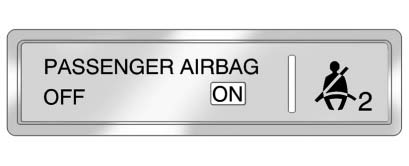
United States

Canada
When the vehicle is started, the passenger airbag status indicator will light ON and OFF, or the symbol for on and off, for several seconds as a system check. If you are using remote start to start the vehicle from a distance, if equipped, you may not see the system check. Then, after several more seconds, the status indicator will light either ON or OFF, or either the on or off symbol to let you know the status of the right front passenger frontal airbag.
If the word ON or the on symbol is lit on the passenger airbag status indicator, it means that the right front passenger frontal airbag is enabled (may inflate).
If the word OFF or the off symbol is lit on the passenger airbag status indicator, it means that the passenger sensing system has turned off the right front passenger frontal airbag.
If, after several seconds, both status indicator lights remain on, or if there are no lights at all, there may be a problem with the lights or the passenger sensing system. See your dealer for service.
WARNING
If the airbag readiness light ever comes on and stays on, it means that something may be wrong with the airbag system. To help avoid injury to yourself or others, have the vehicle serviced right away
Charging System Light

The charging system light comes on briefly when the ignition is turned on, but the engine is not running, as a check to show the light is working.
The light turns off when the engine is started. If it does not, have the vehicle serviced by your dealer.
If the light stays on, or comes on while driving, there may be a problem with the electrical charging system. Have it checked by your dealer. Driving while this light is on could drain the battery.
When this light comes on, the Driver Information Center (DIC) also displays a message.
If a short distance must be driven with the light on, be sure to turn off all accessories, such as the radio and air conditioner.
Malfunction Indicator Lamp
A computer system called OBD II (On-Board Diagnostics-Second Generation) monitors the operation of the vehicle to ensure emissions are at acceptable levels, helping to maintain a clean environment. The malfunction indicator lamp comes on when the vehicle is placed in ON/RUN, as a check to show it is working. If it does not, have the vehicle serviced by your dealer.
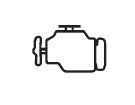
If the malfunction indicator lamp comes on while the engine is running, this indicates that the OBD II system has detected a problem and diagnosis and service might be required.
Malfunctions often are indicated by the system before any problem is apparent. Being aware of the light can prevent more serious damage to the vehicle. This system also assists the service technician in correctly diagnosing any malfunction.
Notice: If the vehicle is continually driven with this light on, the emission controls might not work as well, the vehicle fuel economy might not be as good, and the engine might not run as smoothly. This could lead to costly repairs that might not be covered by the vehicle warranty.
Notice: Modifications made to the engine, transmission, exhaust, intake, or fuel system of the vehicle or the replacement of the original tires with other than those of the same Tire Performance Criteria (TPC) can affect the vehicle's emission controls and can cause this light to come on. Modifications to these systems could lead to costly repairs not covered by the vehicle warranty. This could also result in a failure to pass a required Emission Inspection/ Maintenance test. See Accessories and Modifications on page 10‑2.
This light comes on during a malfunction in one of two ways:
Light Flashing: A misfire condition has been detected. A misfire increases vehicle emissions and could damage the emission control system on the vehicle. Diagnosis and service might be required.
To prevent more serious damage to the vehicle:
• Reduce vehicle speed.
• Avoid hard accelerations.
• Avoid steep uphill grades.
• If towing a trailer, reduce the amount of cargo being hauled as soon as it is
possible.
If the light continues to flash, find a safe place to stop and park the vehicle. Turn the vehicle off, wait at least 10 seconds, and restart the engine. If the light is still flashing, follow the previous steps and see your dealer for service as soon as possible.
Light On Steady: An emission control system malfunction has been detected on the vehicle.
Diagnosis and service might be required.
The following may correct an emission control system malfunction:
• Check that the fuel cap is fully installed. See Filling the Tank on page 9‑49. The diagnostic system can determine if the fuel cap has been left off or improperly installed. A loose or missing fuel cap allows fuel to evaporate into the atmosphere.
A few driving trips with the cap properly installed should turn the light off.
• Check that good quality fuel is used. Poor fuel quality causes the engine not
to run as efficiently as designed and may cause stalling after start-up, stalling
when the vehicle is changed into gear, misfiring, hesitation on acceleration, or
stumbling on acceleration.
These conditions might go away once the engine is warmed up.
If one or more of these conditions occurs, change the fuel brand used.
It may require at least one full tank of the proper fuel to turn the light off.
If none of the above have made the light turn off, your dealer can check the vehicle. The dealer has the proper test equipment and diagnostic tools to fix any mechanical or electrical problems that might have developed.
Emissions Inspection and Maintenance Programs
Depending on where you live, your vehicle may be required to participate in an emission control system inspection and maintenance program. For the inspection, the emission system test equipment will likely connect to the vehicle's Data Link Connector (DLC).
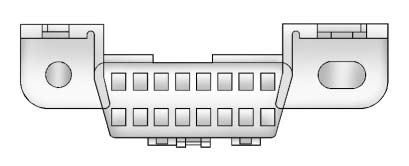
The DLC is under the instrument panel to the left of the steering wheel. See your dealer if assistance is needed.
The vehicle may not pass inspection if:
• The malfunction indicator lamp is on with the engine running, or if the light
does not come on when the ignition is turned to ON/RUN while the engine is off.
See your dealer for assistance in verifying proper operation of the malfunction
indicator lamp.
• The OBD II (On-Board Diagnostics) system determines that critical emission control
systems have not been completely diagnosed. The vehicle would be considered not
ready for inspection. This can happen if the 12-volt battery has recently been replaced
or run down. The diagnostic system is designed to evaluate critical emission control
systems during normal driving. This can take several days of routine driving.
If this has been done and the vehicle still does not pass the inspection for lack of OBD II system readiness, your dealer can prepare the vehicle for inspection.
Brake System Warning Light
The vehicle brake system consists of two hydraulic circuits. If one circuit is not working, the remaining circuit can still work to stop the vehicle. For normal braking performance, both circuits need to be working

Metric

English
The brake indicator light should come on briefly as the engine is started. If it does not come on have the vehicle serviced by your dealer.
When the ignition is on, the brake system warning light comes on when the parking brake is set. The light stays on if the parking brake does not fully release. If it stays on after the parking brake is fully released, there is a brake problem.
Have the brake system inspected immediately.
WARNING
The brake system might not be working properly if the brake system warning light is on.
Driving with the brake system warning light on can lead to a crash. If the light is still on after the vehicle has been pulled off the road and carefully stopped, have the vehicle towed for service.
If the light comes on while driving, a chime sounds. Pull off the road and stop. The pedal might be harder to push or go closer to the floor.
It might also take longer to stop.
If the light is still on, have the vehicle towed for service.
Antilock Brake System (ABS) Warning Light
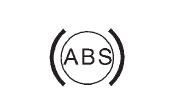
For vehicles with the Antilock Brake System (ABS), this light comes on briefly when the engine is started.
If the light does not come on, have it fixed so it will be ready to warn if there is a problem.
If the ABS light comes on and stays on while driving, stop as soon as possible and turn the ignition off.
Start the engine again to reset the system. If the light stays on after driving at a speed above 20 km/h (13 mph), see your dealer for service. A chime may also sound when the light comes on steady.
If the regular brake system warning light is not on, the vehicle still has brakes, but not antilock brakes.
If the regular brake system warning light is also on, the vehicle does not have antilock brakes and there is a problem with the regular brakes.
Lane Departure Warning (LDW) Light
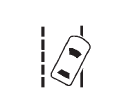
If it does not, have the vehicle serviced by your dealer. If the system is working normally the indicator light then turns off.
This light also comes on green when the system is switched on and ready to operate.
Forward Collision Alert (FCA) Warning Light
These lights are located on the center of the instrument panel.
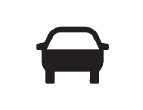
The vehicle ahead light comes on when a vehicle is ahead and a possible collision can occur.

The forward collision alert comes on and warns when following a vehicle closely. The light then flashes when a vehicle is being rapidly approached.
Traction Off Light

This light comes on briefly while starting the engine. If it does not, have the vehicle serviced by your dealer. If the system is working normally, the indicator light then turns off.
The traction off light comes on when the Traction Control System (TCS) has been turned off by pressing and releasing the TCS/StabiliTrak button.
This light and the StabiliTrak OFF light come on when StabiliTrak is turned off.
If the TCS is off, wheel spin is not limited. Adjust driving accordingly.
StabiliTrak® OFF Light
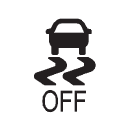
This light comes on when the StabiliTrak system is turned off.
If the Traction Control System (TCS) is off, wheel spin is not limited. If the StabiliTrak system is off, the system does not assist in controlling the vehicle. Turn on the TCS and the StabiliTrak system and the warning light turns off.
Check the DIC for applicable messages.
Traction Control System (TCS)/StabiliTrak® Light
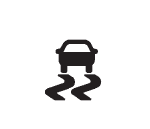
The StabiliTrak or Traction Control System (TCS) indicator/warning light comes on briefly when the engine is started.
If the light does not come on, have the vehicle serviced by your dealer.
If the system is working normally, the indicator light turns off.
If the light is on and not flashing, the TCS, and potentially the StabiliTrak system have been disabled. A DIC message may display. Check the DIC messages to determine which feature(s) is no longer functioning and whether the vehicle requires service.
If the indicator/warning light is on and flashing, the TCS and/or the StabiliTrak system is actively working.
Tire Pressure Light
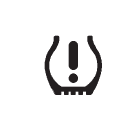
For vehicles with the Tire Pressure Monitor System (TPMS), this light comes on briefly when the engine is started. It provides information about tire pressures and the TPMS.
When the Light Is On Steady
This indicates that one or more of the tires are significantly underinflated.
A Driver Information Center (DIC) tire pressure message may also display. Tire and Loading Information label
When the Light Flashes First and Then Is On Steady
If the light flashes for about a minute and then stays on, there may be a problem with the TPMS. If the problem is not corrected, the light will come on at every ignition cycle.
Engine Oil Pressure Light
Notice: Lack of proper engine oil maintenance can damage the engine. Driving with the engine oil low can also damage the engine. The repairs would not be covered by the vehicle warranty.
Check the oil level as soon as possible. Add oil if required, but if the oil level is within the operating range and the oil pressure is still low, have the vehicle serviced. Always follow the maintenance schedule for changing engine oil.
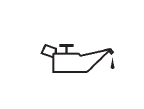
The oil pressure light should come on briefly as the engine is started.
If it does not come on, have the vehicle serviced by your dealer.
If the light comes on and stays on, it means that oil is not flowing through the engine properly. The vehicle could be low on oil and might have some other system problem. See your dealer.
Fuel Economy Light

For vehicles with the fuel economy mode light, it comes on when the eco (economy) switch, located on the center console near the shifter, is pressed. For vehicles with a Driver Information Center (DIC) an ECO MODE ON message displays.
Press the switch again to turn off the light and exit the fuel saver mode.
Low Fuel Warning Light
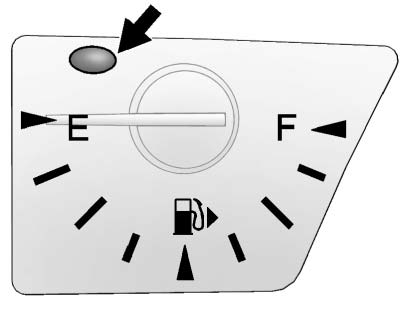
English Shown, Metric Similar
This light comes on for a few seconds when the ignition is turned on as a check to indicate it is working. If it does not come on, have it fixed.
The low fuel warning light is a circle located on the fuel gauge. This light comes on and a chime sounds periodically when the vehicle is low on fuel. The light goes off when fuel is added to the fuel tank.
For vehicles with a Driver Information Center (DIC)
Security Light
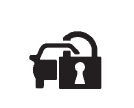
The immobilizer light should come on briefly as the engine is started.
If it does not come on, have the vehicle serviced by your dealer.
If the system is working normally, the indicator light turns off.
If the light stays on and the engine does not start, there could be a problem with the theft-deterrent system.
High-Beam On Light

The high‐beam on light comes on when the high-beam headlamps are in use.
Front Fog Lamp Light
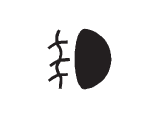
The front fog lamp light comes on when the fog lamps are in use.
The light goes out when the fog lamps are turned off.
Lamps On Reminder

For vehicles with the lamps on reminder light, it comes on when the lights are in use.
Cruise Control Light
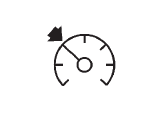
For vehicles with cruise control, the cruise control light is white when the cruise control is on and ready, and turns green when the cruise control is set and active.
The light turns off when the cruise control is turned off.






